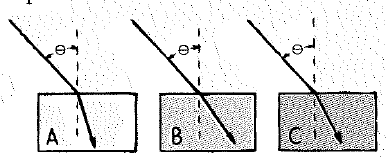
Identical rays of light enter three transparent blocks composed of different materials. Light slows upon entering the blocks. Rank the blocks according to the

To Rank: The blocks as per speed of light that travels in them.
Explanation of Solution
Introduction:
When the light travels in the vacuum and enters into the new medium like water, air, the speed is decreased in proportion to the refractive index. So, the amount of reduction in speed is a function of the refractive index.
Naturally, when light travels through air and enters into a different medium such as water orglass, the speed and wavelength of the light are reduced but the frequency remains unaltered.
A light ray bends towards the normal while traversing a material medium if it travels faster in it as compared to the one it enters from.
By observing three figures, concerning the density variation in three different materials and the angle of ray in the material, it can be concluded that B has the highest speed, C has the medium speed and the A has the least speed.
Conclusion:
From the figure, it is concluded that material B has refracted more than C and C refracted more than A.
Chapter 29 Solutions
Conceptual Physics: The High School Physics Program
Additional Science Textbook Solutions
Concepts of Genetics (12th Edition)
Physics for Scientists and Engineers: A Strategic Approach, Vol. 1 (Chs 1-21) (4th Edition)
Human Anatomy & Physiology (2nd Edition)
Organic Chemistry (8th Edition)
Chemistry: An Introduction to General, Organic, and Biological Chemistry (13th Edition)
Genetic Analysis: An Integrated Approach (3rd Edition)
- A sinusoidal wave with wavelength 0.400 m travels along a string. The maximum transverse speed of a point on the string is 3.00 m/s and the maximum transverse acceleration is 8.10×104m/s2. What is the propagation speed v of the wave? What is the amplitude A of the wave?arrow_forwardPlease help show how to find the standard deviation and margin of error. Please explain what they mean. Thanks!arrow_forwardPlease solve and answer the problem correctly please. Thank you!!arrow_forward
- Please solve and answer the question correctly please. Thank you!!arrow_forwardShould the results of your experimental Coefficient of Static Friction for the Wooden Block for the wooden block (Data Table 1) and the wooden block with the added mass (Data Table 2) be similar? Explain why or why not. Determine whether the results of the experiment are within a reasonable experimental error (< 10%) by calculating the % difference. Please help with showing how to calculate and with explaination, I'm not sure. Thanks!arrow_forwardNo chatgpt pls will upvote Alreadyarrow_forward
- Please solve and answer the question correctly please. Thank you!!arrow_forwardPlease don't use Chatgpt will upvote and give handwrittenarrow_forward5. An object moves in a horizontal plane with constant speed on the path shown. At which marked point is the magnitude of its acceleration greatest? A B Ꭰ E Carrow_forward
- No chatgpt pls will upvotearrow_forwardNo chatgpt pls will upvotearrow_forwardUniform Circular motion. 1. Mini Lecture 2. Let the position of a particle be given by: (t) = Rcos (wt)i + Rsin (wt)j 3. Calculate the expression for the velocity vector and show that the velocity vector is tangential to the circumference of the circle. 4. Calculate the expression for the acceleration vector and show that the acceleration vector points radially inward. 5. Calculate the magnitude of the velocity and magnitude of the acceleration, and therefore show that v2 a = Rarrow_forward
 College PhysicsPhysicsISBN:9781305952300Author:Raymond A. Serway, Chris VuillePublisher:Cengage Learning
College PhysicsPhysicsISBN:9781305952300Author:Raymond A. Serway, Chris VuillePublisher:Cengage Learning University Physics (14th Edition)PhysicsISBN:9780133969290Author:Hugh D. Young, Roger A. FreedmanPublisher:PEARSON
University Physics (14th Edition)PhysicsISBN:9780133969290Author:Hugh D. Young, Roger A. FreedmanPublisher:PEARSON Introduction To Quantum MechanicsPhysicsISBN:9781107189638Author:Griffiths, David J., Schroeter, Darrell F.Publisher:Cambridge University Press
Introduction To Quantum MechanicsPhysicsISBN:9781107189638Author:Griffiths, David J., Schroeter, Darrell F.Publisher:Cambridge University Press Physics for Scientists and EngineersPhysicsISBN:9781337553278Author:Raymond A. Serway, John W. JewettPublisher:Cengage Learning
Physics for Scientists and EngineersPhysicsISBN:9781337553278Author:Raymond A. Serway, John W. JewettPublisher:Cengage Learning Lecture- Tutorials for Introductory AstronomyPhysicsISBN:9780321820464Author:Edward E. Prather, Tim P. Slater, Jeff P. Adams, Gina BrissendenPublisher:Addison-Wesley
Lecture- Tutorials for Introductory AstronomyPhysicsISBN:9780321820464Author:Edward E. Prather, Tim P. Slater, Jeff P. Adams, Gina BrissendenPublisher:Addison-Wesley College Physics: A Strategic Approach (4th Editio...PhysicsISBN:9780134609034Author:Randall D. Knight (Professor Emeritus), Brian Jones, Stuart FieldPublisher:PEARSON
College Physics: A Strategic Approach (4th Editio...PhysicsISBN:9780134609034Author:Randall D. Knight (Professor Emeritus), Brian Jones, Stuart FieldPublisher:PEARSON





